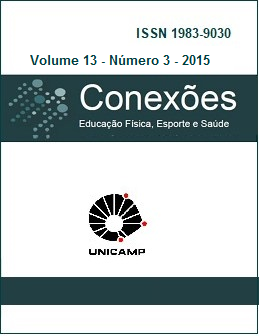Abstract
The cooperation between teammates and the way in which such cooperation occurs is
fundamental to understand the social processes within a team. In the particular case of
sport such cooperation is inevitable in team sports. Therefore, recent metrics based in
Graph Theory have been providing a new approach that allows potentiating the
understanding of quantitative information. Therefore, this review aims to share the
techniques and possibilities of Social Network Analysis in the specific case of sport and
how such approach can potentiate the social studies. Will be presented and discussed in
this review techniques to analyze the network properties, as well as metrics to determine
the dependency between teammates and the prominence levels of players.
References
LUSHER, D., ROBINS, G., KREMER, P. The application of social network analysis to team sports. Measurement in Physical Education and Exercise Science, v. 14, n. 4, p. 211–224, june 2010.
CLEMENTE, F.M. et al. Using network metrics to investigate football team players ’connections: a pilot study. Motriz, Rio Claro, v . 20, n. 3, p. 262-271, set. 2014.
CLEMENTE, F.M. et al. Using network metrics in soccer: a macro-analysis. Journal of Human Kinetics, v. 45, p. 123–134, july 2015.
LIGHT SHIELDS, D. L. et al. The relationship between leadership behaviors and group cohesion in team sports. Journal of Psychology, v. 131, n. 2, p. 196–210, ago. 1997.
CARRON, A. V.; BRAY, S. R.; EYS, M. A. Team cohesion and team success in sport. Journal of Sports Sciences, v. 20, n. 2, p. 119–26, feb. 2002.
LOUGHEAD, T. M.; HARDY, J. An examination of coach and peer leader behaviors in sport. Pshychology of Sport and Exercise, v. 6, n. 3, p. 303–312, mar. 2005.
MORGAN, P. B. C., FLETCHER, D.; SARKAR, M. Defining and characterizing team resilience in elite sport. Pshychology of Sport and Exercise, v.14, n. 4, p. 549–59, apr. 2013.
FRANSEN, K. et al. The myth of the team captain as principal leader: extending the athlete leadership classification within sport teams. Journal of Sports Sciences, v. 32, n. 14, p. 1389-1397, dec. 2014.
ABBOTT, A. Of time and space: the contemporary relevance of the chicago school. Social Forces, v. 75, n. 4, p. 1149–82, dec. 1997.
MORENO, J. L. Who shall survive? foundations of sociometry, group psychotherapy and socio-drama. Oxford: Beacon House, 1953.
KNOKE, D.; YANG, S. Social network analysis. London: SAGE, 2008.
BARNES, J. A.; HARARY, F. Graph theory in network analysis. Soc Networks, v. 5, p. 235–44, apr. 1983.
PAVLOPOULOS, G. A. et al. Using graph theory to analyze biological networks. BioData Min., v. 4, n. 1, p. 10, mar. 2011.
HORVATH, S. Weighted network analysis: Applications in Genomics and Systems biology. New York: Springer, 2011.
HAGGARTY, S. J.; CLEMONS, P. A.; SCHREIBER, S. L. Chemical genomic profiling of biological networks using graph theory and combinations of small molecule perturbations. Journal of the American Chemical Society, v.125, n. 35, p.10543-10545, apr. 2003.
BURT, R. S.; KILDUFF, M., TASSELLI, S. Social network analysis: foundations and frontiers on advantage. Annual Review of Psychology, v. 64, p. 527–547, july 2013.
HAMMOND, D. K.; VANDERGHEYNST, P., GRIBONVAL, R. Wavelets on graphs via spectral graph theory. Applied and Computational Harmonic Analysis, v. 30, n. 2, p.129-150, june 2011.
PRELL, C.; HUBACEK, K.; REED, M. Stakeholder analysis and social network analysis in natural resource management. Society & Natural Resources, v. 22, n. 6, p. 501-518, 2009.
LEVI-STRAUSS, C. The elementary structures of kinship. Boston, Beacon, 1969.
PARK, R. The concept of social distance. Journal of Applied Sociology, v. 8, p. 339-344, 1924.
GRUND, T. U. Network structure and team performance: the case of english premier league soccer teams. Social Networks, v. 34, n. 4, p. 682–690, sept. 2012.
WELLMAN, B.; BERKOWITZ, S. D. Structural analysis in the social sciences 2 social structures: a network approach. Cambridge: Cambridge University, 1988.
OTTE, E.; ROUSSEAU, R. Social network analysis: a powerful strategy, also for the information sciences. Journal of Information Science, v. 28, n. 6, p. 441–453, jun. 2002.
WETHERELL, C.;, PLAKANS, A.; WELMANN, B. Social network, kinship, and community in Eastern Europe. Journal of Interdisciplinary History, v. 24, p. 639-663, oct. 1994.
TICHY, N. M.; TUSHMAN, M. L.; FOMBRUN, C. Social network analysis for organizations. Academy of Management Review, v. 4, n. 4, p. 507–519, 1979.
WASSERMAN, S.; FAUST, K. Social network analysis: Methods and applications. New York: Cambridge University, 1994.
SCOTT, J. Social network analaysis. London: SAGE, 2000.
HANNEMAN, R. A.; RIDDLE, M. Introduction to social network methods. Riverside, University of California, 2005.
GRÉHAIGNE, J. F.; BOUTHIER, D.; DAVID, B. Dynamic-system analysis of opponent relationship in collective actions in football. Journal of Sports Sciences, v. 15, n. 2, p.137–149, feb. 1997.
WATTS, D. J.; STROGATZ, S. H. Collective dynamics of “small-world” networks. Nature. v. 393, p. 440–442, may 1998.
RAVASZ, E. et al Hierarchical organization of modularity in metabolic networks. Science, v. 297, n. 5586, p.1551-1555, nov. 2002.
COUCEIRO, M. S.; CLEMENTE, F. M.; MARTINS, F. M. L. Toward the evaluation of research groups based on scientific co-authorship networks : the robocorp case study. The Arab Gulf Journal of Scientific Research, v. 31, n. 1, p. 36–52, dec. 2013.
KALAMARAS, D. Social networks visualizer (SocNetV): social network analysis and visualization software. Social Networks Visualizer. Disponível em: http://socnetv.sourceforge.net, 2014.
The Conexões: Educação Física, Esporte e Saúde Journal uses the license of Creative Commons (CC), thus preserving the integrity of articles in an open access environment.


